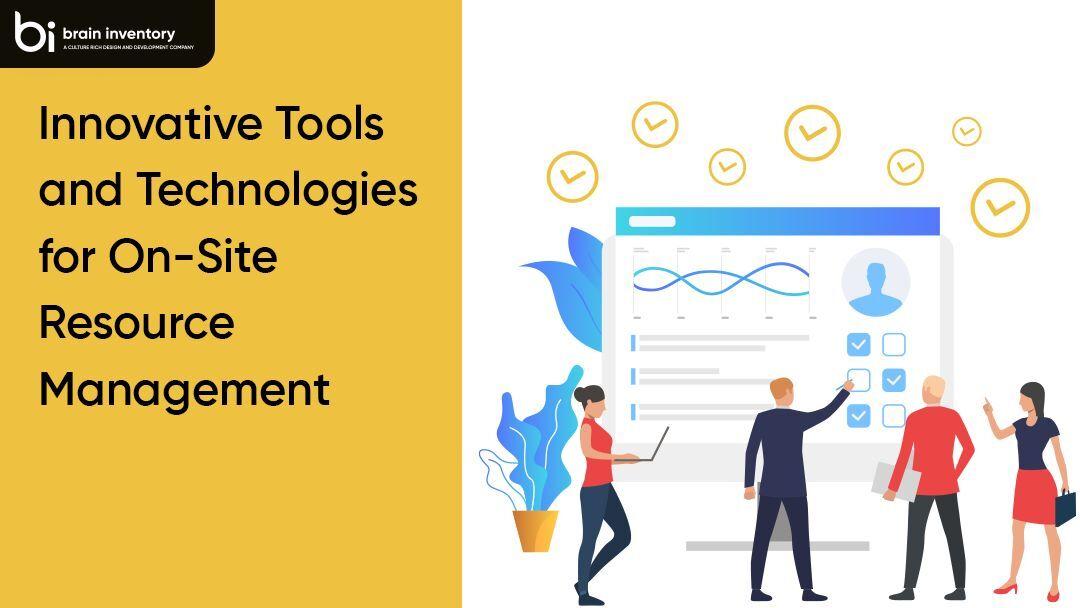Innovative Tools and Technologies for On-Site Resource Management

Quick Summary: Resource management tools and technology play a crucial role in project management software. Every project requires the management of materials, tools, equipment, people, or resources. Regardless of the quality of your project plan, if you are unable to effectively manage your resources, your project will experience setbacks.
Before discussing the top five resource management tools, it is important to establish a clear definition of resource management and the software utilized to regulate them throughout projects.
What Is Resource Management?
Resource management involves the strategic allocation, scheduling, and planning of resources to achieve project completion. While project managers commonly supervise the resource management process, other leaders may also take on this responsibility. Effective resource management necessitates the utilization of various tools and techniques, including project management software.
5 Must-Have Resource Management Tools
Not every resource management tool is identical. If you are in search of resource management tools that can effectively address your resource management requirements, then it is essential to acquire one that incorporates these five essential tools.
Gantt Chart:
The Gantt chart has long been a fundamental component of project management, serving as a reliable means of scheduling and organizing projects across a designated timeline. Its effectiveness is particularly evident in more conventional approaches like the waterfall methodology. ProjectManager offers advanced Gantt charts that enable the establishment of interdependencies, the application of critical path filtering, and the setting of baselines to monitor project deviations, ultimately facilitating adherence to the predetermined schedule.
Timesheets:
Time tracking is an essential feature of resource management software. Without built-in timesheets, you’ll have to use another program or manually enter time data, which is inefficient. The ideal solution has timesheets that seamlessly log hours worked and lock entries after submission to prevent tampering. The project Manager delivers secure timesheets that automatically update based on team members’ work across project views like lists, boards, and more. These timesheets streamline payroll by enabling managers to efficiently approve hours logged on assigned tasks. Timesheets also support budgeting by revealing when work is behind schedule so you can reallocate resources accordingly. In short, integrated timesheets like those in Project Manager optimize time tracking and provide critical visibility into resource usage and project progress.
Workload Calendars:
Your employees are your most valuable assets. It is essential that you ensure they are operating at maximum productivity without being overburdened. Tools for managing personnel should provide visibility into the number of responsibilities allocated to each team member.
The workload visualization in ProjectManager accomplishes this. You can immediately identify at a glance who has an excessive workload and who has too little to do. You are able to efficiently reallocate tasks directly within the workload chart, conserving valuable time and balancing your project team so they work more productively.
Resource Management Dashboards:
Utilizing dashboards for monitoring the progress and performance of resources is a valuable tool that can enhance the effective management of projects. The Project Manager’s live dashboard eliminates the need for manual setup, unlike inferior resource management tools. Our project dashboard automatically captures project data and converts it into six project metrics that are presented in charts and graphs, making it simple to read and understand. You can access an instant status report at any time, which includes an overview of the project’s health and a bar chart that displays your team’s workload. In addition, other metrics such as time, cost, tasks, and progress are also available.
Resource Management Reports:
While dashboards provide valuable high-level insights, more granular data is necessary for optimal resource management. Customizable reports deliver the in-depth details that dashboards lack, empowering more informed decision-making. Reports can be tailored to specific information needs, aiding resource optimization. There are reports for project/portfolio status, workload, availability, timesheets, tasks, and more. Reports can be shared with stakeholders in various formats to maintain open communication. Reports complement dashboards by enabling deep analysis and driving strategic resource allocation through comprehensive data.
Resource Management Techniques
Project managers utilize various resource management methods to predict, arrange, designate, balance, and enhance resources while carrying out a project.
Resource Forecasting:
Project managers are tasked with accurately assessing the necessary resources and timelines for their initiatives to align with a company’s existing priorities and roadmaps. In order to achieve this, project managers must explicitly outline the boundaries and work activities that constitute the project to determine what capabilities and inputs are obligatory to accomplish all components. By transparently mapping the breadth of work required, project managers can then evaluate what resources are imperative to procure and how those resources can be secured based on other ongoing organizational efforts.
Resource Allocation:
Resource allocation means looking at the resources you have, like people, equipment, money and time, as well as what jobs need doing, to figure out which team members have the right abilities for each task. It also involves making sure those people can get access to the resources they need to complete their assignments on schedule.
Resource Leveling:
Resource leveling refers to reallocating work across a project team to address problems with overloading or scheduling conflicts. By having a solid grasp of the capabilities each team member possesses, you can match tasks to their skills in order to optimize resource utilization.
Resource Utilization:
Thorough planning of project resources is just as crucial as monitoring how those resources are used. Project managers must closely follow how resources are utilized to identify any that are not being employed optimally. They can then reallocate those resources or modify the resource management strategy.
Resource Smoothing:
Resource smoothing is a technique that involves postponing less important tasks in order to finish a project on time with the existing resources. It works by utilizing the slack or float on those non-critical tasks to push them back without impacting the critical path. By delaying the less critical tasks, you can reallocate your resources to focus on completing the activities on the critical path first and then later come back to the less significant work. The goal is to smooth out resource usage over the course of the project while still adhering to the completion date.
Conclusion
Creative resource allocation requires intuition as well as methodical thinking; a universal solution does not exist. That said, companies that implement robust resource management systems and adopt forward-thinking resource distribution strategies can anticipate greater triumphs and far fewer difficulties. Though resource management is as much an art as it is a science and a one-size-fits-all approach is impossible, organizations utilizing enterprise-level resource management software and embracing innovative resource management concepts will likely thrive where others falter. Brain Inventory is a top-rated provider of customizable and durable solutions that facilitate the management and scheduling of your personnel. Our reach extends to multiple nations, and a plethora of successful companies that feature in the Fortune 500 list are presently utilizing and reaping the rewards of our product. Furthermore, Brain Inventory also equips you with the necessary resources you need for managing your team, organizing your project portfolio management, and automating your professional services. This workforce management software is adaptable to fit any industry and is instrumental in resolving any immediate staffing issues.

Have an idea?
Get in touch, we’d be
happy to hear from you
We are always looking out for new collaborations, whether you are a client who is passionate about a project or a talent who is interested in joining our team, our doors are always open.
locate us

India (HQ)
618, Shekhar Central, Palasia Square, A.B Road, Indore, Madhya Pradesh, 452001
+918109561401

United Kingdom
Brain Inventory, SBVS, 8 Roundhay Road, Leeds, UK, LS7 1AB
+18008209286

Canada
44 Main Street East Milton, ONCanada L9T 1N3
+4166696505

Jordan
185 Wasfi Al-Tal Street, Ammon Oasis Complex P.O Box 4724 Amman 11953 Jordan
+960770781000

USA
720 Seneca St Ste 107 Seattle, USA 98101
+1(206)6533419
if it's digital,we'll make it.
- Numetric - Online Accounting Software similar to QuickBooks
- Bloomia - Kegel exercise
- Virifi - Blockchain Powered Document Certification & Signing Platform
- Revolution Travel CRM - Custom CRM Built for Travel Agents
- Fatoura - Online Invoicing Platform
- My Fit Mantra - Your health partner
- Ocureel - Relation Building and video sharing Application